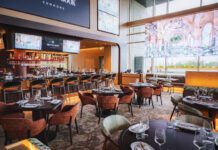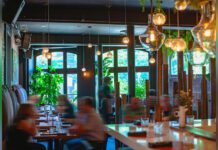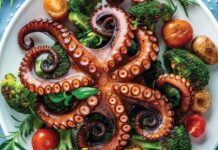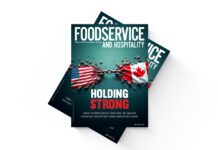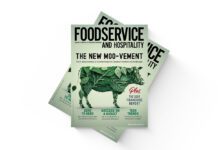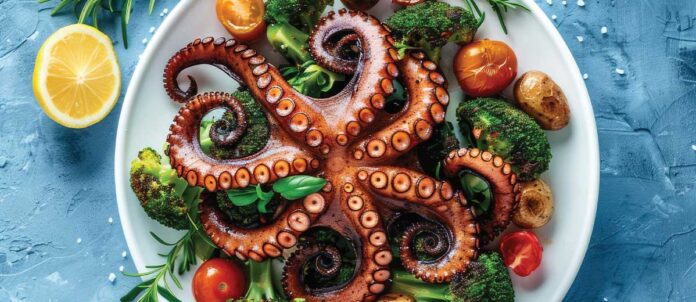By Jenny Febbraro
With a plethora of sustainable seafood options and a general consensus that fish trumps meat in the health department, ordering fish can provide restaurant goers with a “feel-good” choice that checks all the boxes.
According to sustainable-seafood.ca, Canada exported more than $7.6 billion worth of fish and seafood in 2023 to more than 115 countries globally. Surrounded by three oceans — the Pacific, Arctic and Atlantic — Canada also lays claim to the longest coastline and largest freshwater lake system in the world, which is why sustainability has become so critical to our nation’s economy, as well as the foodservice industry.
But beyond the restaurant industry’s key role in supporting the Canadian economy, its dedication to sustainable seafood translates to valuing our Indigenous communities. As of Oct. 4, 2024, the Government of Canada launched a $5-million-dollar initiative with the Indigenous Fisheries Monitoring Fund to support Indigenous groups as they increase fisheries monitoring and catch reporting. In a statement, the Honourable Diane Lebouthillier, Minister of Fisheries, Oceans and the Canadian Coast Guard stated, “Indigenous harvesters have always made an important contribution towards sustainability through fishery monitoring and stewardship in Canada…which is essential to effective fish stock management
in Canada.”
At Tofino, B.C.’s Wickaninnish Inn, executive chef Clayton Fontaine says that responsible seafood practices guide his menu creation. “That means serving seafood that is in abundance — so not in scarce supply — as well as seafood sourced locally, which is easy here on the west coast of Vancouver Island,” he says. “It’s important for us — and guests — to know where the fish is coming from. Our fish are often caught the same day as they are served.”
At The Pointe Restaurant, which itself has expansive floor-to-ceiling views of the Pacific Ocean, Fontaine features Pacific halibut, which is caught on local day boats and can be traced back to its location of origin. “We also incorporate local seaweed,” says Fontaine. “These might appear in our table d’hồte or seasonal menus. We have people in Tofino who harvest locally. We use it for flavour — but it’s also really nutritious.” A customer entrée favourite is the charcoal-grilled sablefish featuring kohlrabi, dashi, huckleberry, and sesame.
“Since becoming executive chef, one of the things I’ve enjoyed most is building relationships with these newly starting fishing businesses,” explains Fontaine, who worked three years as a sous chef at The Pointe before becoming executive chef. One of his favourites is Naas Foods, which provides organic kelp and seaweed products, such as umami-rich kelp flakes. It also happens to be an Indigenous-led team who harvest along the coast of Clayoquot Sound. “Knowing where your food comes from and building relationships with the people who harvest is what makes creating the dishes so special.”
Back in Southern Ontario, Restaurant Pearl Morissette features French-inspired cooking that uses sustainable practices. It’s also earned a Michelin Green Star for its foraging of regional ingredients and environmental integrity. Located in the Niagara region an hour southwest of Toronto, the site includes 42 acres of land, a winery, farm, orchard, bakery and restaurant.
“We look to the ecology around us to build our menu,” says chef and owner, Eric Robertson, who takes his seafood seriously. “There’s an exceptional quality of sustainable, Canadian seafood available on both coasts.”
Robertson sources seafood regularly from the Bonavista, N.L supplier Foggy Shoals Seafood. “Their seafood is not only sustainable, but freshly caught in the Bonavista Bay,” he says. “We regularly get crab, mussels, scallops, sea urchin and cod from them. When it comes to sustainable seafood, knowing your source is key.” One sample dish is the sea urchin from Newfoundland paired with Badger Flame beets, pickled quince, and savoury sabayon seasoned with habanada peppers.
“We also like to mix different ingredients with oysters,” he says. One of Robertson’s creations features an East Coast oyster topped with yogurt, lovage and alyssum blossoms. He says the province is an often-overlooked resource for supplying first-class, sustainable seafood to all regions of Canada. “I like to joke that cod should be featured on the Newfoundland provincial flag,” he laughs. But on a more serious note, he explains, “Sustainability is often overlooked in the culinary world.”
While Restaurant Pearl Morissette excels at promoting locale ingredients through its menu, it heightens the experience even more through presentation. Robertson recalled one example: “We took our last garden kohlrabis, hollowed it out and then filled it with fresh shucked scallops, apple juice, preserved pine cones and coriander, then put the top of the vegetable back on.”
But does sustainable always equate to local? Not necessarily, according to the Toronto-based Chiado restaurant. “We source much of our seafood from the Azores region,” explains Albino Silva, Chiado’s owner and operator. “These are sustainably sourced by local Portuguese fishermen and they would include ingredients for some of our most popular dishes, including sea bass, rockfish, and also different types of cod.”
Silva says that Portugal has always been a global player in providing sustainable fish to an international audience. “What’s good about Portugal is they don’t have the huge fleets of fishermen or huge ships that a country like Spain next door would have, for example,” says Silva. “We find that guests are more conscious now of sustainable practices than ever before. People still prefer wild fish over farmed fish — and yes, they do ask about the source of the fish as well.” That said, Silva notes that some of the farm fisheries he uses also use sustainable practices.
One of the most unique seafood offerings at Chiado, that isn’t common at other restaurants, is its Assorda, what Silva calls a “dry soup” or “Portuguese Bread soup.” Known as a peasant dish, Silva has heightened the experience in a way that highlights a variety of sustainable seafood options, likening it to a French bouillabaise that combines different types of fish.
“It’s rare to find this at a restaurant, but the secret really is in the depth of flavour from the fish stock, which we make in house, of course,” says Silva. “We have a shrimp and lobster stock, as well as a monk-fish stock. Then you take some garlic and extra-virgin olive oil and cook it for about 30 minutes, then you add monkfish and other types of fish, add your heavy Portuguese bread, throw in lots of coriander, drop a couple of eggs on top, and you have perfection.”
When asked what the secret is, Silva notes that it’s all in the seafood. “So much of our industry and the restaurant industry in general is reliant on our oceans. It’s critical that we continue these sustainable practices and that we source from the smaller fleets of ships, the local fishermen.”


